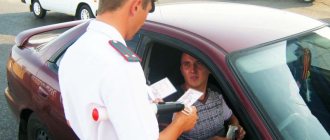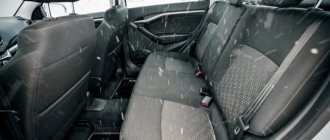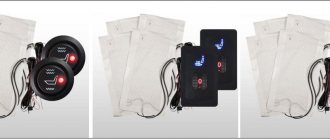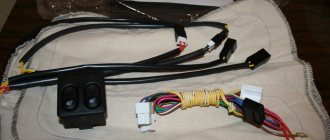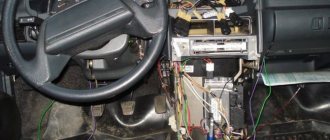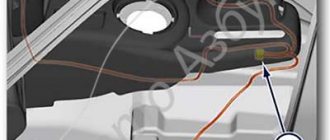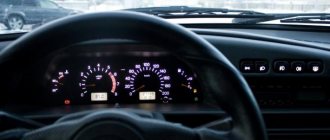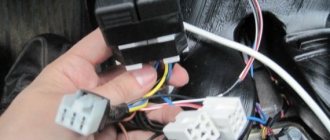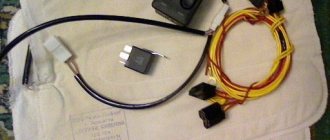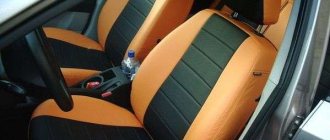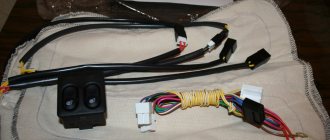Fit Setting
The main rule when sitting is to press the entire chair tightly against your back. That is, there should be no distance between the lower back and the seat.
Having taken a comfortable position, you need to:
- press the pedals fully: gas,
- clutch;
In this situation, it is important to observe absolutely all points:
- the pose does not cause discomfort,
- the legs can press freely, without the need to strain or stretch for this;
- your knees should not rest on the steering wheel;
- heel position – only on the floor;
- The angle of bent knees is approximately 120 degrees.
If the seat is not installed correctly, there will be incorrect sensations that must be corrected:
- knees are too bent - you need to move back;
- When you press the brake, your leg becomes fully straightened - move it closer to the steering wheel.
Position of feet on pedals
We checked the position of our hands on the steering wheel, now we are learning how to correctly place our feet on the pedals. The main condition is that when driving, the legs do not “wander” along the floor of the body. When you move your foot from one pedal to another, lifting it off the floor, the center of gravity may shift, and control will deteriorate accordingly. For a driver with little driving experience, this is doubly dangerous: a mistake is possible when choosing a pedal (instead of the brake, the gas is pressed).
The best option is to place the foot of the right foot between the gas-brake pedals. Control is performed by turning the foot to the left or right, without lifting the heel from the floor. This position is the most convenient for safe control. The brake-clutch pedals require increased effort when pressed, so they are pressed with the middle part of the foot.
A car with an automatic transmission (automatic transmission) does not have a clutch pedal; instead, there is a rest for the left foot. Control of the brake and gas is performed in the same way as for a car with manual transmission, with the right foot.
Sit down and buckle up
Knowing how to sit behind the wheel correctly will not help if you do not wear a seat belt while driving. Most cars have an airbag. The volume of all airbags, when deployed, is calculated based on the condition that the passenger is not only fastened with a seat belt, but did it correctly.
So, correct, this means that the belt:
- runs along the entire chest from the shoulder down;
- never appears near the throat;
- presses the torso tightly to the chair (but does not compress the chest too much);
- is securely held in place by a latch.
Checking preparation for movement:
- sit on the seat;
- fasten your seat belt;
- clarify the distance of the steering wheel from the driver’s hands;
- check the ability to quickly control the car pedals.
If necessary, the installation of the driver's seat must be adjusted.
Useful information about seats on the Prior
Welcome! What will be included in the list of useful information, you ask? Firstly, we will walk you through the basic everyday things that a person should know about car seats, namely, we will show you clearly how to remove the headrests from the seats, and we will also show you how to correctly fold out the rear seat of a car to transport large items. cargo and some more useful information will be given about the seats.
Adjusting the position of the front seat and head restraints on the car:
Note! In fact, adjusting the seats is an integral part of any car, since when buying a new car, all people are different and in order for each person to sit comfortably in the car, it is necessary to adjust the seat exactly to it (We are talking about the front seats), but remember once and for all , it is recommended to adjust the seat only when the car is stationary (Apply only to the driver), because when adjusting the seat, for example in length, you may lose control of the car because if you do not properly fix the seat on the car, there is a possibility that it will suddenly move backwards and thus you may lose control of the car, so be careful!
1) First, let's talk about how you can adjust the front seat of a car, so in order to adjust it, for example, in length (scientifically, longitudinally), you will need to pull up the locking lever with your hand as shown below in the photo and only after this, use your body movements to adjust the front seat as you need, but after you release the lever, move your body either forward or backward and thereby you will fix the seat and it will stand clearly in one place.
2) On the side of each of the front seats there is a handle that is made of a round shape, and thanks to this handle it will be possible to adjust not the front seat itself, but only its back, for this you need to rotate this handle in the desired direction and thereby achieve a position that is comfortable for you.
3) Now let’s talk a little about the headrests that are built into the front and rear seats of cars, so adjustment of these things is also necessary, because if, for example, a taller person is sitting in the back seat, then accordingly the headrest will need to be adjusted to his height, and in order to do this, you will need (regardless of whether the front or rear seat) grab the headrest itself with both hands and do exactly those actions that you need, for example, if you need to lower the headrest then press it from above with force and it will begin to fall a little, and if you need to lift it, then do the same operation only a little in reverse, namely, grab the lower part with both hands and, using force, lift the headrest up with your hands and it will lock itself.
Note! The headrests in the Priora are fixed using clamps that are installed on forks, which in turn are connected to the headrests themselves, so if you want to either lower or raise the headrest, then simply use force and overcome the resistance of the clamps, position the headrest in the way you need!
Rear seat layout on car:
Note! On Lada Priora cars, there are two seat backs in the back and one armrest that goes between them, so each backrest can be removed separately, for example, you will need to move a couple of long boards, then you remove one of the two backrests or simply remove the armrest that is installed in the middle, and thus you have one more free seat in the back in order to put any passenger on it!
Adjusting car seats
Modern seats allow adjustment in different directions and planes. You can change the angle of the backrest and pillow, the height of the pillow, move it lengthwise, change the position of the headrest and armrests, etc.
The adjustment drive can be:
- mechanical;
- electric;
- pneumatic.
The mechanical drive is considered classic. Different car models have their own adjustment methods. These could be special levers or an adjustment wheel. Suffice it to recall the adjustment methods in Soviet cars.
Mechanical seat adjustment
The electric adjustment drive is considered more modern and comfortable. The controls are located on the door panel in the driver's field of vision or located directly on the seat. Built-in electric drives are powered from the vehicle's on-board network. They can change the position of the backrest, pillow, headrest, side pillows and lumbar support. It all depends on the configuration of a particular model.
Special attention can be paid to the “seat memory” function. The driver adjusts the optimal position of the seat according to his parameters and as it suits him. Next, you need to select the desired option in the chair control by pressing the “Set” or “M” (Memory) button. This way you can save several positions. This is convenient when the car is used by several drivers. For example, husband and wife. The driver selects his saved profile in the settings, and the seat takes the desired position. In addition, the position of the mirrors and steering wheel can be remembered.
Electrically adjustable seat with memory function
Pneumatic actuators use air. Often these options are combined – pneumoelectric. Air is supplied to certain areas of the chair. This way you can change not only the basic positions, but also the geometry of the seat itself. Mercedes-Benz has made great progress in this matter.
Seat ventilation
Ventilation systems are installed in expensive premium and business class car models. Some upholstery materials, such as leather, are known to get very hot in the sun. The presence of ventilation will quickly cool the material to a comfortable temperature.
Several fans are built into the seat, which take air from the passenger compartment, thereby cooling the surface of the seats. Standard systems use two cushion fans and two backrest fans, but there may be more.
To allow air from the fans to pass freely through the seat upholstery, a special mesh material called a spacer is used. This material not only allows air to pass through, but also regulates its flow through the chair. The system is also powered from the on-board 12V network.
Seat with installed fans
Not all cars have such systems, but you can also install them yourself by purchasing a kit. To install, you need to remove the casing and install fans, having previously prepared a place for them in the foam rubber. The connection occurs through the control unit.
Some craftsmen who do not want to spend money on a ready-made system try to make it themselves. Computer coolers are usually used as fans. Instead of a spacer, you can use a fine plastic mesh for plants.
Comfort behind the wheel is very important for any driver, especially if the work involves long and daily travel. Modern car seats have many useful features. You can be sure that such technologies will only improve.
Heated seats
Heated seats are available in many modern cars, even in basic configurations. The technology itself appeared back in 1955.
The heating operates from the on-board power supply. Technically this is a simple system. Consists of the following elements:
- A heating element. As a rule, this is a wire that is coated with Teflon and a nichrome spiral.
- Heat-resistant upholstery that covers the heating elements.
- Thermostat.
- Controls.
Heating elements operate on the principle of a resistor, i.e. heat up due to resistance. They are located in the back and cushion of the chairs. The power wires pass through the relay. A thermostat is required to regulate the temperature. It prevents the elements from overheating. When they heat up to the set temperature, the relay turns off. When the temperature drops, the system turns on again. As a rule, the driver has a choice of up to three heating options: low, medium and high.
Heated seat
If your car does not have a seat heating function, now it is possible to install the heating yourself. There are many options on the market. There is nothing complicated in the design and installation, but you will have to remove the seat upholstery. The heating elements are glued to the surface of the chair, contacts are made and connected to the control via a relay.
If you don’t want to crawl under the seat upholstery, you can install an overhead heating element in the form of a cover. Such devices are connected via the cigarette lighter.
Preliminary preparation
Adjusting the driver's seat height is not possible without adjusting the general steps. When considering this issue, it is also necessary to touch upon such points as the optimal angle for the legs, seat tilt, and steering wheel height. Before starting the task, you need to sit in the driver's seat.
You need to sit down straight so that all parts of your body are pressed tightly against the chair. In the future, this will help avoid back pain and possible spinal injuries.
Seat angle
should be brought as close to the straight position as possible. It is not necessary to achieve ideal settings here, and it is almost impossible. A suitable angle is between 110-95 degrees. The correct tilt adjustment is checked by placing your arms, which are not very extended, on the steering wheel. The wrists of the limbs should touch the steering circle, and the palms, without lifting the shoulder blades from the back of the seat, should bend freely.
The next step is adjusting the steering wheel
. In height, it is set parallel to the back of the driver's seat, but with such an attitude that it does not interfere with the view of the instrument panel. The best position is achieved when the palms are slightly lower than the shoulders and correspond to the hour hands pointing to the numbers 9 or 3. You also need to remember to adjust the distance to the steering wheel. The elbows here should be bent 120 degrees, with a gap between the chest and the handlebars of 30 to 45 cm.
